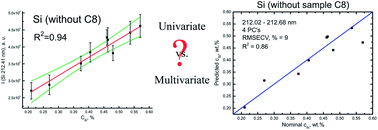Comparison of single- and multivariate calibration for determination of Si, Mn, Cr and Ni in high-alloyed stainless steels by laser-induced breakdown spectrometry
Abstract
The quantitative analysis of high-alloyed steels by LIBS is usually complicated by overlap of the analytical lines with iron lines due to the complex structure of the emission spectra of each component. To overcome this problem, we compared two calibration strategies in the current research work. Univariate regression analysis was used for a number of analytical lines of Si, Mn, Ni, and Cr with and without strong spectral interference with other lines. Several methods of data pre-processing (for example, by normalization using an internal standard or baseline correction) to compensate for matrix effects or the pulse to pulse deviations of the analytical signal have been compared with the calibration curves constructed with the use of peak intensities. As an alternative to the univariate strategy, multivariate calibration based on principal component regression (PCR) was used in this work. We examined two criteria separately to select the most predictive model. The minimal values of the relative Root Mean Square Error of Cross Validation (RMSECV, %) provided the best prediction accuracy while the use of the well known F-criterion reduced the number of principal components up to 4 or 5 for each analyte without significant worsening of prediction capability. The measurements within four spectral windows (210–230 nm, 280–300 nm, 345–365 nm and 400–420 nm) were carried out on a set of 10 standard samples. Univariate calibration for Cr, Ni and Mn provided the best prediction (R2 = 0.996) if an appropriate reference line could be found and analytical lines were not overlapped with others. The best prediction for Si (R2 = 0.94) was obtained with the use of a peak signal of the Si 212.41 nm line without normalization. Otherwise, PCR provided good predictive capability (RMSECV, % = 3, 4, 5 and 9 of quantification of Mn, Cr, Ni and Si, respectively) in the spectral ranges where numerous matrix lines strongly interfered with analytical lines.


 Please wait while we load your content...
Please wait while we load your content...